
Who We Are – The People Behind Casa Loltún
A Lady with Heart – and a Guy with Spreadsheets
A Mexican lady who follows her heart (Mina) and a German guy who tends to overthink things (me, Tobias). Sounds like the perfect recipe for a calm, balanced partnership?
Not quite. But definitely an exciting one. Mina grew up in Mexico City and moved to Germany at 25. That’s where we met, got married, and now live with our three crazy great kids, two overexcited dogs, and three food-obsessed rabbits.

_edited_p.png)
In 2020 – after a summer trip with friends to Cancún – Mina came up with the idea of buying a vacation home there. But Cancún had gotten pretty pricey, and Mérida felt more interesting and full of potential. Little by little, I warmed up to the idea.
But since we already had a vacation home in Mexico, I was mainly thinking in terms of investment – no money pit, please. And that’s how the idea of Casa Loltún was born.
Now heart and head came together – while I was still juggling numbers in Excel to figure out if it made sense, Mina was already deep into property searches and chatting with realtors.
Real estate websites, Google Earth, and a giant paper map (“Wait… where’s Calle 43 again?”) became our tools of choice.
We made a shortlist, set up viewings, and Mina flew to Mérida to check everything out in person. I quickly realized: buying a property in Mexico can be an adventure – but read on and see for yourself...
Have fun, Tobias
The Search for a Property – This Is Where the Story Begins
House Spoting in Mérida
01
Despite having around one million residents, Mérida still feels more like a large village than a bustling city. That also means the central area is best explored on foot – or even by bike. Traffic isn’t too bad either, so having a car can help if you want to get an initial overview.
We’ll take you on a short taxi ride through the historic center, where you’ll spot Mérida’s typical colorful houses. We start at the corner of Calle 55 and 72. Along the way, you’ll see how beautifully restored homes sit side by side with old, crumbling ones (audio in English).
Our First Attempt...
02
“The light blue house” became the nickname for our favorite listing. Great location, good size, and the price felt right. Our architect, Xavier, joined Mina for the viewing – and gave his approval. Sometimes things just fall into place quickly. Why not, right? That’s what we thought.
But during the visit, Xavier noticed the property seemed a bit shorter than what was listed. When asked, the owner casually explained that his neighbor had once wanted to expand. Since he ran out of space, he simply continued building... onto the lot.




...Failed.
03
The blue house was unoccupied, so no one noticed at first. And if no one complains within a certain time frame, well – that’s just how things stay. In fact, there are even companies in Mérida that specialize in selling “problem properties” – with unclear boundaries, disputed ownership, or any issue you can think of.
In this case, the official land records didn’t match the reality on the ground. And the owner showed zero interest in fixing the situation (let alone being concerned about it). So, we moved on and started looking at the next property.


A New Attempt...
04
A well-preserved colonial house near Parque Santiago, a bit farther from the city center, also looked like a great fit – so we made an offer. The seller took his time, then came back with a counteroffer.
But his counteroffer was actually higher than the original asking price. Looking for an explanation? Yeah... us too.
In the end, we agreed on the original price, and the notary process could finally begin. Or so we thought...
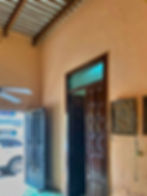
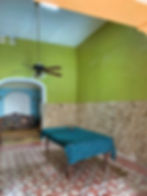
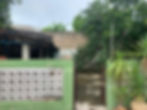

...With Better Luck?
05
We had previously discussed the possible reconstruction with Xavier. An additional floor should be built, a pool and another building in the back of the property. Here is a short video about it (audio in German).
As in other countries, the usual way of buying a house in México is through a notary with a trust account - to protect buyer and seller. However, our seller now had the idea of receiving the purchase price directly into his bank account. Even the intervention of broker and notary did not help. So we withdrew here as well.
Back to Start...
06
Meanwhile, the agent for the blue house wasn’t too thrilled either – the commission he thought was in the bag was gone, and the property became hard to sell. He ended up speaking with the owner several times, and eventually convinced him to fix the land records.
While we were already considering a possible third option, the agent reached out again: were we still interested? The issues had been resolved. This time, nothing stood in the way – and we finally bought the “light blue house” (which, by the way, is now light yellow).


Planning and Construction
Planning Phase (and Rising Costs)
07
Spoiler: We ended up spending triple what I had originally budgeted. Not because of rising Covid-era costs or the falling euro – but because we decided to add a full second floor to the main house and put up a two-story apartment building at the back of the lot.
Since the property is located in Mérida’s historic center, the existing house is protected as a landmark. Any changes had to be approved by Mexico’s National Institute of Anthropology and History (INAH). Unsurprisingly, our first proposal was rejected.


Demolition and Renewal
08
Monument protection in Mérida usually applies only to the front part of a house – meaning the façade and the front rooms. Part of the rear main building had already been demolished, and another section was beyond saving. After a few more discussions with INAH, the planned changes were finally approved. (A future sale would be impossible without valid INAH documentation.)
For this kind of work, you don’t typically see heavy machinery – just strong arms and serious sledgehammers. Since some load-bearing walls had to be taken out, temporary buttresses were used to support the ceilings.




Building the Main House
09
The main house was restored and received a second floor. Because of the monument protection, the new upper level had to be set back slightly. The original pasta tile flooring was partially removed during construction and then re-laid afterward.
The front door was moved to the right, creating a small foyer that leads either into the main house or toward the apartments. A highlight is the long panoramic window in the master bedroom – with a wide windowsill that’s been turned into a cozy seating nook with cushions.
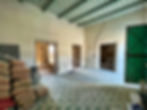
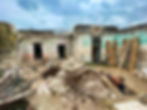


...and the Apartments
10
The apartment house was newly built from the ground up. Properties in Mérida are typically long and narrow – I’ve seen lots just 3 meters wide and over 40 meters deep. So we placed the apartment building at the very back and created a garden and pool area in between.
Each apartment features a queen-sized bed, a cozy seating area, a kitchenette, and a bathroom with a walk-in shower. A nice detail: the showers have a slim window with a private, screened view outside. All floors are finished with classic pasta tiles.
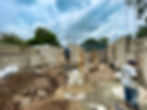



...and the Garden & Pool Area
11
What’s the most important thing in a tropical climate? Air conditioning is a must, of course – but let’s be honest, a pool makes all the difference. Ours was dug the old-school way: with shovels and pickaxes. Next to it, we built a sun deck with a large shaded roof.
The garden had to be lush and green, but also easy to maintain. So we went with gravel-covered ground and installed an automatic irrigation system – a must when summer temperatures often soar past 100°F (38°C).




Interior Design
Furnishing the House
12
While searching for furniture, we checked out online platforms (like MercadoLibre), furniture stores in Mérida, and carpenters – including suppliers for hotels. Some of the prices were surprisingly high, even by European standards.
Eventually, we discovered Roots Mueblería y Arte Útil – a small, family-run furniture workshop in Mérida, now led by third-generation women. Roots mainly uses reclaimed wood, like naturally fallen trees, and often works with Mexican Tzalam wood. Tzalam is sometimes called “Mayan Walnut” because of its resemblance to American Black Walnut.
Break Out: Visit Roots on Facebook




Interior Style
13
So every piece of furniture is handmade by local artisans in Mérida, often using reclaimed Mexican hardwoods like Tzalam (Mayan walnut) or Parota (burl wood). The decorative touches are also typical for Mérida – like the hand-knotted wall hangings you'll see throughout the house.
A classic feature of old colonial homes are the high ceilings – often 5 or 6 meters – with exposed wooden beams. We added plenty of ceiling fans and chose large statement lamps. Outside, you’ll find cozy rocking chairs, sun loungers, and small tables to relax in the shade.



